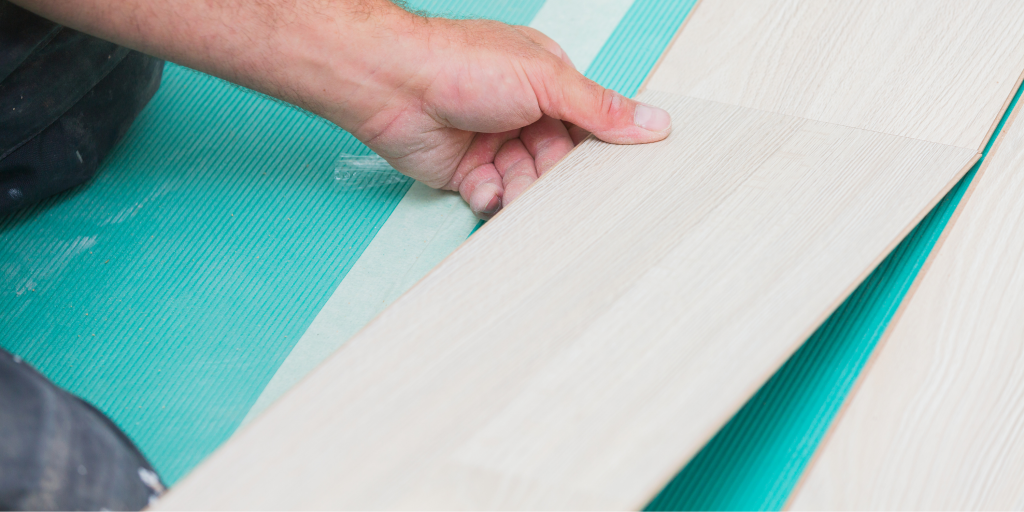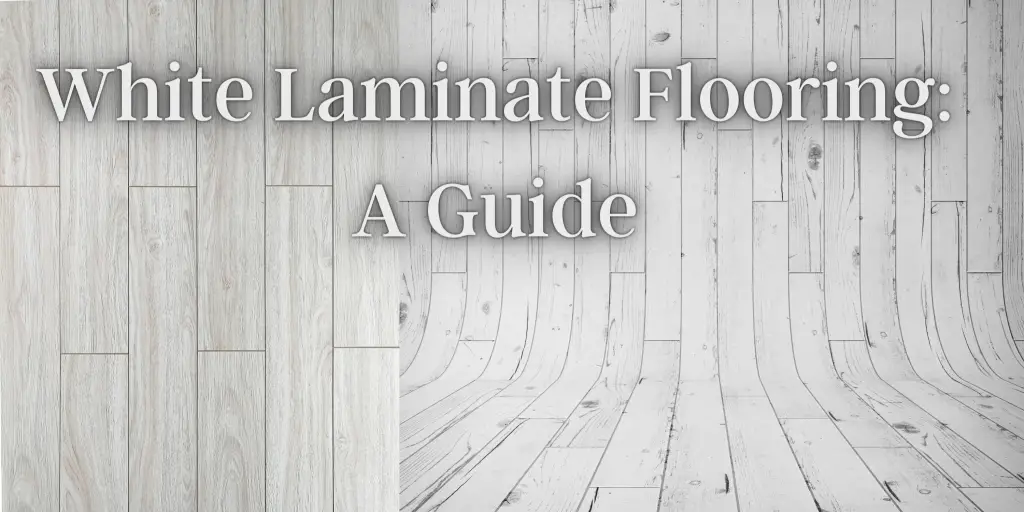When it comes to decorating your home, White Laminate Flooring is one of the essential elements to consider. After all, the floor is what you walk on every day. This means that not only does it need to look good, but it also needs to be durable and comfortable underfoot.
You could opt for carpeting, which has its advantages (it’s soft!), or you could go with hardwood or stone floors, which are arguably more stylish choices; however, if neither of those options holds much appeal for you, why not consider.
What is White Laminate Flooring
White laminate flooring is a light-toned synthetic flooring material that is manufactured by fusing together layers of different materials. These floors usually simulate wood and consist of a protective layer that keeps the colored layer from becoming damaged over time.
White laminate boards are usually sold in a variety of hues including plain white, white wood, marble, and many others. These floors provide a significant level of style without compromising on comfort or durability. And because so many homeowners are making this purchase these days, there are also plenty of options for this type of flooring on the market.
Read this guide below to learn more about how it works, where to buy it, and why you might want to put it in your living room or kitchen.
Another interesting read: Tips to Effectively Clean High Gloss Laminate Flooring
The Benefits of Installing White Laminate Flooring
Laminate flooring is a solid and durable construction material that is also water-resistant. This means that you won’t have to worry about it warping or splitting when you use your washing machine or pour a cup of hot coffee on it by mistake.
Laminate flooring is so resistant to the elements that some brands even offer a lifetime guarantee against discoloration, whether from sunlight or liquids. Plus, most suppliers will tell you how much weight their boards can support, allowing you to buy them safely in the knowledge they’ll be able to cope with people walking across them without breaking.
Additional Accessories Required for Installation
If you’ve decided that white laminate flooring is the right choice for your home, you’ll probably be thinking about buying some soon. Before you do, remember there are a few other things you will need before installation can begin. For example:
Flooring Adhesive
This adhesive provides an easy way to bond the boards together without using nails or screws (which aren’t always suitable). It would be best if you used adhesive specifically designed for this purpose.
Flooring Glue
If you’re working with hardwood, stone, or ceramic tiles, you’ll need to “glue” them down to secure them properly. However, many manufacturers of laminate flooring state that glue isn’t usually necessary when installing this type of floor.
Sandpaper
You will need some high-grit sandpaper to smooth down the edges of the boards before installation. This is designed to remove any splinters or rough patches to create a friendly, even finish.
Tape Measure
A tape measure helps measure your room and make sure that all your boards are cut correctly. Without measuring accurately, you could have wasted money on the wrong size or type of flooring.
Hammer
You may also need a hammer for utilizing certain types of white laminate flooring, such as click-together planks. This can depend on what you purchase, so always double-check with your supplier before leaving the store.
Pencil
If you are painting or wallpapering your walls before installation begins, it’s essential to mark out where the boards will go so that they’re not placed in front of any windows, skirting boards, or radiators. A pencil is perfect for marking these positions on the walls.
These are just some of the things you should buy before installation, but there are plenty more which we’ll look at later in the guide.
Advantages of White Laminate Flooring

White laminate flooring is a type of floor made to look like hardwood. It has many benefits, but it is also more expensive than other types of flooring. Here are some reasons why you might want to buy white laminate flooring:
- The floors are easy to clean and can be washed with soap and water if they get dirty
- The color on the boards may fade over time, but the surface will not crack or peel
- It is easier to install than wood floors and can be installed over existing tiles or carpets
- It is fire and water-resistant
- White laminate flooring often has a style that looks like natural hardwood, so you do not have to worry about it looking out of place in your house
Disadvantages of White Laminate Flooring
Even these beautiful floors have a couple of drawbacks that you should consider before you invest in them. Here is a quick look at the disadvantages of this type of flooring.
- They can be cold under the feet
- Some find them slippery when walking on them.
- They can also show marks from furniture more than wood floors.
- If you spill something on the surface, it will likely leave a mark until you clean it up. This can be especially problematic if someone in your family wears glasses or contacts because these marks make objects look blurry.
- White floors may also show footprints since they are much lighter than other flooring materials.
To avoid the problems that come with white laminates: Get high-quality flooring that is more resistant to damage and marks; buy flooring that has a textured surface; use furniture pads under heavier pieces of furniture like couches and away from places where people walk most often; clean spills immediately; make sure your kids are wearing shoes when they walk on the floor; if you wear glasses or contacts, wipe them off before walking on your laminate floors.
What Is White Laminate Flooring Made Of?
Manufacturers of white laminate flooring usually use MDF as the core material. This is because it’s durable, but it has a high-density level which means that even though the boards are relatively thin, they are still strong and won’t warp or bend easily. The face-grain of the board is then covered with melamine resin, which provides a smooth white surface you can sink your feet into.
In comparison, manufacturers of laminate floors made from solid wood will typically opt for multiple different layers of plywood or hardwood so that each layer forms a veneer. These panels have a much longer lifespan than those made from MDF, but they are also much thicker and less easy to install.
What Are The Benefits Of Installing White Laminate Flooring?
Laminate flooring is a solid and durable construction material that is also water-resistant. This means that you won’t have to worry about it warping or splitting when you use your washing machine or pour a cup of hot coffee on it by mistake.
Laminate flooring is so resistant to the elements that some brands even offer a lifetime guarantee against discoloration, whether from sunlight or liquids. Plus, most suppliers will tell you how much weight their boards can support, allowing you to buy them safely in the knowledge they’ll be able to cope with people walking across them without breaking.
What Are The Different Types Of White Laminate Flooring?
Manufacturers create white laminate flooring using the same kind of melamine resin as they do with colored boards. This means that besides being available in a wide range of shades, you can also buy laminates that have come pre-treated with features like water-resistant coatings and scratch-resistant finishes.
However, as well as choosing between light and dark tones, you’ll also need to think about your preferred style before purchasing any white laminate flooring. Manufacturers offer this construction material in three different formats: planks, parquet, and strips. Each one has its benefits and disadvantages depending on where it’s going to be used and how much money you’re willing to spend:
Wooden Planks Are Suitable For:
Living Rooms: If you’re looking for a rustic or traditional look, planks are the best option because they offer a more luxurious aesthetic. However, if you’re buying flooring for an area that takes heavy foot traffic, this style is not recommended as it can easily break or scratch.
Bedrooms and Bathrooms: Wooden planks are commonly used in bathrooms and bedrooms as they give floors a classic but stylish appearance. Plus, because manufacturers now have extensive experience making boards from melamine resin, the risk of these areas being damaged by water or humidity is very low.
Kitchens: Although wood isn’t an exceptionally resilient construction material, laminate flooring made from engineered solid wood can cope with multiple uses, including kitchens. If you’re worried about them being stained by grease and oil, opt for boards that have been pre-treated with anti-marks and scratches.
What Are The Benefits Of Wooden Planks?
Other than the fact that they can be laid in virtually any design imaginable, wooden planks offer many excellent benefits over different types of flooring. For example, because they are made from solid wood, this means they are incredibly resilient to heavy foot traffic, pets destroying them, and spills – plus, most suppliers will tell you exactly how much weight their floors can support so you’ll be able to buy your planks safe in the knowledge that they won’t break when stood on.
Thanks to their water-resistant construction, wooden planks are easy to clean and maintain. Plus, you won’t have to worry about being stained by anything accidentally spilled on them because they aren’t porous or absorbent like solid wood floors.
Conclusion
Is white laminate flooring a good solution for your home? We believe that this flooring type offers a very clean and luxurious look and feel. However, not everyone is fond of light-colored floors because they quickly show signs of dirt and grime. If you have pets or young children, then a darker laminate floor might be a better option, and it will still offer the same soft and luxuriously smooth feel as vinyl flooring with lighter tones.
We hope that you found this guide useful! If you want to learn more about these and other types of flooring, then you should take a look at some of the other guides we have on Health Handymen. By reading the articles on our site, you can learn to do any handyman task.

